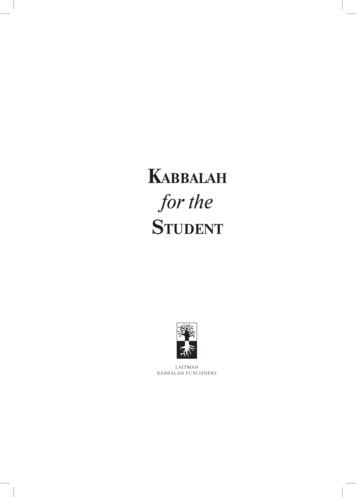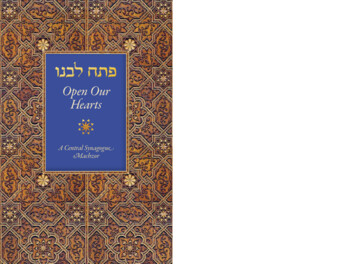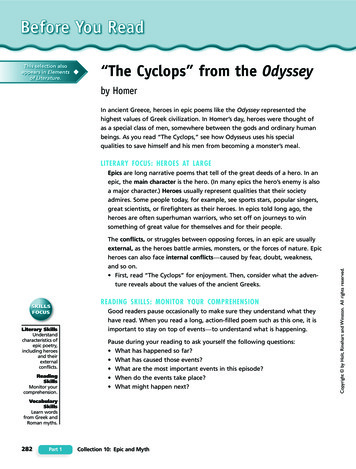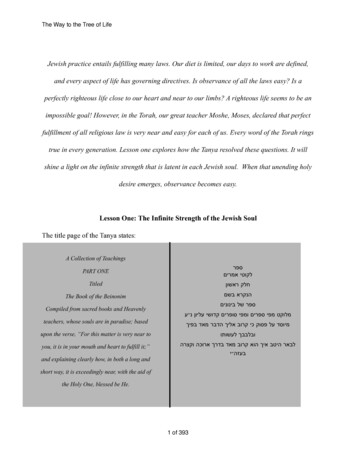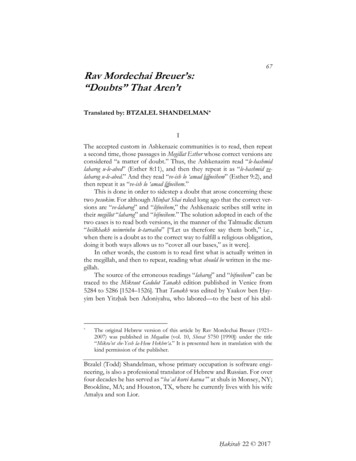
Transcription
Rav Mordechai Breuer’s:“Doubts” That Aren’t67Translated by: BTZALEL SHANDELMAN*IThe accepted custom in Ashkenazic communities is to read, then repeata second time, those passages in Megillat Esther whose correct versions areconsidered “a matter of doubt.” Thus, the Ashkenazim read “le-hashmidlaharog u-le-abed” (Esther 8:11), and then they repeat it as “le-hashmid velaharog u-le-abed.” And they read “ve-ish lo ‘amad bifneihem” (Esther 9:2), andthen repeat it as “ve-ish lo ‘amad lifneihem.”This is done in order to sidestep a doubt that arose concerning thesetwo pesukim. For although Minḥat Shai ruled long ago that the correct versions are “ve-laharog” and “lifneihem,” the Ashkenazic scribes still write intheir megillot “laharog” and “bifneihem.” The solution adopted in each of thetwo cases is to read both versions, in the manner of the Talmudic dictum“heilkhakh neimrinhu le-tarvaihu” [“Let us therefore say them both,” i.e.,when there is a doubt as to the correct way to fulfill a religious obligation,doing it both ways allows us to “cover all our bases,” as it were].In other words, the custom is to read first what is actually written inthe megillah, and then to repeat, reading what should be written in the megillah.The source of the erroneous readings “laharog” and “bifneihem” can betraced to the Mikraot Gedolot Tanakh edition published in Venice from5284 to 5286 [1524–1526]. That Tanakh was edited by Yaakov ben Ḥayyim ben Yitzḥak ben Adoniyahu, who labored—to the best of his abil-*The original Hebrew version of this article by Rav Mordechai Breuer (1921–2007) was published in Megadim (vol. 10, Shevat 5750 [1990]) under the title“Mikra’ot she-Yesh la-Hem Hekhre‘a.” It is presented here in translation with thekind permission of the publisher.Btzalel (Todd) Shandelman, whose primary occupation is software engineering, is also a professional translator of Hebrew and Russian. For overfour decades he has served as “ba al korei kavua ” at shuls in Monsey, NY;Brookline, MA; and Houston, TX, where he currently lives with his wifeAmalya and son Lior.Ḥakirah 22 2017
68 : Ḥakirah, the Flatbush Journal of Jewish Law and Thoughtity—at eliminating the numerous errors that were common in the Ashkenazic manuscripts of that period. He also added a masorah gedolah and masorah ketanah, which he collected from various manuscripts.The Venice Mikraot Gedolot was reprinted numerous times, in Veniceand also in many other cities, such as Amsterdam and Warsaw. Its finalincarnation can be seen in the Mikraot Gedolot editions that are commonplace in our own communities, all of which are photoreproductions of theWarsaw edition.Notwithstanding that Yaakov ben Ḥayyim labored assiduously overhis Tanakh edition, he failed to create a high-quality product. His Tanakhincludes thousands of errors in spelling, punctuation, and cantillation. Thespelling errors involve, primarily, the plene and defective forms of words,but there are also instances of aleph interchanged with he, bet interchanged with kaf, additions or deletions of voiced vav, and even substitutions of entire words.The first to address these issues was R’ Menaḥem de Lonzano, authorof Or Torah, who corrected all the errors that he found in the MikraotGedolot text of the five books of the Torah. His work was later supplemented by R’ Yedidyah of Norzi, better known as the author of MinḥatShai, who corrected the errors that he found anywhere in Tanakh: in theTorah as well as nevi’im and ketuvim.The corrections and annotations of Minḥat Shai were subsequently accepted by Jewish communities everywhere, and it is often said that theVenice Mikraot Gedolot represents the de facto standard Tanakh versionaccepted by all Jews. This refers, however, not to the Mikraot Gedolot edition published by Yaakov ben Ḥayyim himself, but, rather, to Yaakov benḤayyim’s work as later revised to incorporate also the corrections ofMinḥat Shai.We can now understand, based on all of the above, how the versionof Megillat Esther that was accepted in the Ashkenazic community came tobe. Yaakov ben Ḥayyim’s edition includes twelve spelling errors in MegillatEsther alone. Ten of those errors involve plene and defective spellings:tavo: missing vav (1:19); betulot: missing vav (2:2), yoshev (2:21), va-yavo (4:9),yode‘im (4:11), aḥashverosh (6:2), ve-hilbishu (6:9), u-mishloaḥ (9:22), le-kayyem(9:31), le-rov (10:3).
Rav Mordechai Breuer’s: “Doubts” That Aren’t : 69And then there are the two additional errors, “laharog” and “bifneihem,”which we’ve already mentioned. Ten of these twelve errors—to the exclusion only of “ve-hilbishu”1 and “le-kayyem”2 —were corrected by MinḥatShai.3 And since Minḥat Shai was considered an authority on everythingrelating to the text of Tanakh, we might have expected that all these corrections would have been accepted by every scribe and printer. The textof the megillah would then have conformed in virtually every respect towhat the Masorah had established.What actually happened, however, was somewhat different. Thesoferim [scribes] and printers did in fact accept all the corrections of MinḥatShai concerning plene and defective spellings.4 But the two correctionsthat involved formative letters—“ve-laharog” and “lifneihem”—did not garner wide acceptance in the community. Thus, the Ashkenazic megillahscrolls, as well as the well-known printed megillah editions such as that ofLetteris, which was later reprinted in facsimile editions by the Israeli publishing houses Yavneh, Eshkol, and Sinai, all incorporate the erroneousreadings of Yaakov ben Ḥayyim: “laharog” and “bifneihem.”All this demonstrates that the authority of Minḥat Shai was never accepted as final and absolute, and with that in mind we need to differentiatebetween the corrections of Minḥat Shai to the Torah text, and his corrections to the other books of Tanakh. With regard to the text of the TorahMinḥat Shai followed in the footsteps of Or Torah, who in turn followedRamah, who was among the greatest of the Rishonim, and whose rulingsconcerning the written text of the Torah were accepted in their entiretyby the Ashkenazic community. There were only a small number of issueswhich Ramah himself had left as open questions, and which Or Torah resolved on the basis of his own judgment.The outcome of all this was that the written text of the five books ofthe Torah had been everywhere clarified and resolved based on the testimony of two or even three witnesses, whose authority was sufficient to1234Proof for the plene spelling of ve-hilbishu can be found in the masorah gedolah ofLeningrad B 19a to Daniel 5:19. (The masorah gedolah of Mikraot Gedolot there iscorrupted.) Cf. also note 3, end.Everywhere else “le-kayyem” is spelled with only one yod. If the correct spellingof this one instance was with two yods, the Masorah would have noted that withthe notation “l’ male’.” Cf. also note 3, end.He also corrected one other word that did not need correcting, namely, umishloaḥ (9:19), which he believed should be spelled with a vav after the lamed.Proof for the defective spelling can be found in the masorah gedolah of MikraotGedolot to Esther 3:9.This includes the extraneous correction mentioned in note 3.
70 : Ḥakirah, the Flatbush Journal of Jewish Law and Thoughtremove all doubt from anyone’s mind. But concerning the written text ofnevi’im and ketuvim, including Megillat Esther, things took a different turn.Ramah and Or Torah had dealt strictly with the Torah text, leaving asthe authority for nevi’im and ketuvim only Minḥat Shai; thus, the latter hadto resolve all those issues of his own accord, with no support from othergedolei yisrael. And the opinion of Minḥat Shai alone did not carry sufficientweight to dispel all doubt in the minds of the public.All this explains why the corrections of Minḥat Shai to Megillat Estherwere accepted only in matters of plene and defective spellings, but not inthe two cases involving formative letters, “ve-laharog” and “bifneihem.” Forthere is a well-known halakhah that a megillah is not rendered invalid byerroneous spelling, or even by the omission of entire words, provided onlythat the reader mouths the text correctly.5 Now, errors in plene or defective spelling alone have no effect on how a word is read, whereas errorsin formative letters, on the other hand, would materially affect the reading.Thus, if the text of the megillah used by the reader is in question, and hereads the text exactly as it is written in the megillah, the validity of thereading itself is likewise subject to doubt, with the possible result that theobligation of reading the megillah would not have been fulfilled at all.We can now begin to understand how the Ashkenazic version of Megillat Esther came to exist. Initially, the soferim would write their megillot inaccordance with the Ashkenazic manuscripts that served as the basis ofYaakov ben Ḥayyim’s corrupted edition. Over the course of time, however, as the authority of Minḥat Shai came to be recognized, and his corrections found acceptance in the communities, the soferim would copyYaakov ben Ḥayyim’s text as it had been corrected by Minḥat Shai. Butthey did so only with those corrections that involved plene and defectivespellings. On those issues, there was no question that Minḥat Shai couldbe considered reliable, because, even if it were to come to light that MinḥatShai had erred, there would be no material ramifications, since a megillahcannot in any case be invalidated by errors of that type alone, nor wouldsuch errors affect the actual megillah reading in any way.But when it came to the two changes that do affect the reading, “velaharog” and “lifneihem,” the soferim were hesitant to contravene already established custom, and for that not even the authority of Minḥat Shai wassufficient. In all probability, they reasoned to themselves as follows. Sincethe correct text is a matter of doubt, and a wrong decision could negativelyimpact the entire community, the best approach is to take no action at alland simply maintain the status quo. They therefore retained the old text5See Shulḥan Arukh, O. H. 690:3.
Rav Mordechai Breuer’s: “Doubts” That Aren’t : 71of Yaakov ben Ḥayyim, rather than replacing it with the corrected text ofMinḥat Shai.We can further surmise that there was also a practical considerationbehind the reluctance of the soferim to change the text in these two instances. It was simple enough for the soferim to adopt in practice the decisions of Minḥat Shai concerning plene and defective spellings, for theseare details that would generally go unnoticed by the larger community.Someone purchasing a megillah from a given sofer would not even realizethat the sofer had altered the accepted text of prior generations.But the situation with the two changes affecting the formative lettersis entirely different. All the existing handwritten and printed megillot beingused by the community would still have the readings “laharog” and “bifneihem,” and only this megillah, which the sofer had written for a member ofthat community, would now have new, different readings: “ve-laharog” and“lifneihem.” If that person were to read from his new megillah publicly, theinevitable result would be a tumult in the synagogue, and the listenerswould have no rest until that reader exchanged his megillah for a differentone that was “kosher to the standards of even the most scrupulous,” anduntil he read the accepted versions, “laharog” and “bifneihem.” The purchaser of that megillah would then return to the sofer much aggrieved thatthe latter had tripped him up by selling him a megillah that was not optimally kosher in every respect.“Surely,” the sofer would argue, “no one can expect me to endangermy livelihood simply for the sake of restoring a text attested by no onebut Minḥat Shai, whose opinion in this case might anyway be incorrect.”An allusion to all of the above can be found, it seems, in the words ofR’ Shelomo Ganzfried, author of Keset ha-Sofer. Better known to the Torahcommunity for his Kitzur Shulḥan Arukh, R’ Ganzfried achieved particularrenown among soferim as the author of Keset ha-Sofer, in which he clarifiedthe laws of writing Torah scrolls, and also established the correct versionsof the written text of the Torah and of Megillat Esther.At the point where he discusses the difference of opinion regarding“laharog” vs. “ve-laharog” of Esther 8:11, Ganzfried relates that a certainvery prominent rabbi had demonstrated to him, using a conclusive prooffrom the Masorah, that the correct reading is “ve-laharog,” in accordancewith the opinion of Minḥat Shai. After failing to offer any well-formulatedrefutation of that proof, R’ Ganzfried concludes his discussion as follows:“Nevertheless, it is difficult in my humble opinion to go against established precedent and change prevailing custom.” And this may be understood to mean: Given that the already established custom is to write andalso to read “laharog,” it would be difficult to change the existing custom,
72 : Ḥakirah, the Flatbush Journal of Jewish Law and Thoughtboth because of the lingering doubt in people’s minds about which is thecorrect version, and also because such a sudden, unexpected changewould only aggrieve the community.And so it came to pass that the text of all Ashkenazic megillot is nonconformant to the Masorah. But not only was the erroneous versionfound in all written megillot, it was also the version that was read aloudpublicly on Purim for hundreds of years. We have testimony that still inthe days of the author of Keset ha-Sofer, only one hundred fifty years ago,the Ashkenazic communities would read only that version. If not for theprinciple of “dillugo ‘alai ahavah” [out of love for us, God overlooks ouromissions], we would have to say that, strictly speaking, no one of any ofthose communities during all that time fulfilled his obligation of hearingthe reading of the megillah.But that state of affairs could not persist. For as we know, only thetruth endures; lies cannot endure. The decision of Minḥat Shai, compounded with the thoroughly unambiguous proofs from the Masorah,eventually came to the attention of the Ashkenazic community, and it wasno longer possible to ignore the fact that the version of Megillat Esther thathad been accepted by the Ashkenazim was completely without validity orfoundation, and had become an obstacle to the entire Ashkenazic community, year in and year out.The first halting effort at righting this wrong could be described asdistressingly unsatisfactory. The author of Keset ha-Sofer testifies about hisrebbe, the author of Imrei Eish, that “his custom was to read ‘laharog,’ butthen to say, silently, ‘ve-laharog’.” But what had been the private practice ofone individual, the author of Imrei Eish, later became the dominant customin all Ashkenazic communities: after saying “laharog,” the reader wouldthen add—not silently, however, but aloud—“ve-laharog.” And the analogous treatment was given to “bifneihem” / “lifneihem” as well. In a LuaḥMinhagei Eretz Yisrael by R’ Y. M. Tukchinsky, in the section dealing withthe laws of Purim, we read that there already was a custom to read theentire pasuk twice (that is, once according to the old, erroneous version,and then a second time according to the corrected version of Minḥat Shai).The upshot of all this is that the Ashkenazic practice of repeating thereading of each of the two verses is not an ancient, venerated custompassed down via tradition from generation to generation; rather, it is aninnovation that took hold only in the recent era. We may therefore askourselves whether perhaps the time has finally come to correct these “corrections,” and whether the time is right to resolve this “doubt,” which, inall truth, has no place in the category of doubt at all. The result will beonly to increase the joy of Purim, for no joy can compete with the joy ofresolving doubt.
Rav Mordechai Breuer’s: “Doubts” That Aren’t : 73It is of paramount importance to emphasize that this “doubt” existsonly within the Ashkenazi community and nowhere else. Because the Sephardim—and, it goes without saying, the Yemenites—know nothing atall of this entire upheaval. Their megillot are both written and read correctlyand properly. That is, they write and read “ve-laharog” and “lifneihem,” andit has never even entered anyone’s mind in those communities to cast anydoubt on the issue.This point alone would be a highly compelling justification for us torevisit and reevaluate the whole issue. After all, that there are three different versions of the tefillot—Ashkenazic, Sephardic, and Yemenite—iscommon knowledge. But now it suddenly comes to light that also theTorah in our possession is not just one Torah, but two Torahs (as concerns Megillat Esther, at least6): an Ashkenazic Torah, and a Sephardic andYemenite Torah. And that is a position that no rational person can possibly accept.“LAHAROG” / “VE-LAHAROG”(A) In section 253 of the work Akhelah ve-Okhlah, an ancient and precisecollection of Masoretic lists,7 we find a list of seventy-four word pairs.The first element of each of the pairs in that list begins with vav, andis also a unique occurrence, found in the given form exactly once in allof Tanakh, whereas in every other place in Tanakh where that word isfound, it appears without a leading vav.For example: “ve-dagan ve-tirosh” (Bereshit 27:37), corresponding to which there is only“dagan ve-tirosh” everywhere else (ibid 28, Devarim 33:28, and elsewhere). “ve-shim‘on ve-levi” (Bereshit 35:23), corresponding to which there is only“shim‘on ve-levi” everywhere else (Bereshit 34:25, 49:5, and elsewhere).Among the pairs in that list we find also “ve-laharog u-le-abed,” whichthe Masorah explicitly notes is in the verse that begins with the words“asher natan ha-melekh” (Esther 8:11). It follows that the correct wording67This phenomenon is found also in the Torah itself, where there are three Torahs:Ashkenazi, Sephardi, and Yemenite. It would be very straightforward to resolvethose differences—all in favor of the Yemenite version. But effecting such acorrection in the five books of the Torah would be more problematic. The Ashkenazic and Sephardic customs are quite old, and, moreover, Minḥat Shai gavethem his approval. But in the case of Megillat Esther, the Ashkenazi custom in itscurrent form is less than one hundred years old, and Minḥat Shai ruled against it.Akhelah ve-Okhlah, ed. Z. Fransdorf, Hanover, 5624 (1864).
74 : Ḥakirah, the Flatbush Journal of Jewish Law and Thoughtthere is “ve-laharog u-le-abed,” while everywhere else the correct wording is“laharog u-le-abed” (Esther 3:13, 7:4).A similar though not identical list can be found in the masorah printedat the end of the Mikraot Gedolot (item number 89 of the “vav” section).That list too includes the “ve-laharog u-le-abed” pair. It was the proof fromthat list in Mikraot Gedolot that was brought to the attention of the authorof Keset ha-Sofer, as we’ve mentioned previously.(B) In the same Masorah printed at the end of Mikraot Gedolot (item number 11 of the “lamed” section) we find a list of unique words beginningwith vav-lamed, e.g., “u-le-yamim” (Bereshit 1:14) and “ve-limshol” (ibid. 18).Also mentioned among the words enumerated there is the word “velaharog,” and once again the Masorah states explicitly that the pasukcontaining those words begins with “asher natan ha-melekh” (Esther8:11). Thus, we see conclusively that the given word begins with theconjunctive vav, but in this pasuk only, while in every other instancethe corresponding word appears without the leading conjunctive vav(Esther 3:13, 7:4, and elsewhere). This proof too was brought to theattention of the author of Keset ha-Sofer.(C) The Lenigrad Codex (formerly known as B 19a), written in the year1009, not long after the Masoretic period, is the oldest known extantand intact manuscript of the entire Tanakh. In the Leningrad Codexthere is a Masoretic circle between the two words “le-hashmid” and “velaharog” (Esther 8:11), which is meant to call attention to the masorahketanah marginal note, “l’ ” (i.e., a single lamed followed by an apostrophe). The meaning of that terse notation is that the combination ofthose two words is unique in Tanakh (hence, “l’ ,” an abbreviation for“leit di-khevatteh,” “there is no other like instance”). That Masoretic notation likewise demonstrates that the Masorah considers “ve-laharog” tobe the correct reading. For if we were to suppose, contrarily, that thecorrect reading is “laharog,” the Masorah could not have notated thatword pair with “l’,” given that the word pair “le-hashmid laharog” is notunique, but actually appears in two other places in Tanakh, both ofthem in Megillat Esther (3:13; 7:4).“BIFNEIHEM” / “LIFNEIHEM”Minḥat Shai quotes the Masoretic notation accompanying the word “bifneihem” of Yehoshua 21:42, which says: “Ve-nakotu ve-dein.” The interpretationof that notation is that the word “bifneihem” is found in only two places inTanakh, the one being “ve-nakotu bifneihem” of Yeḥezkel 6:9, and the other“dein”—“this one”—of Yehoshua 21:42, “ve-lo ‘amad ish bifneihem.” MinḥatShai cited that Masoretic note as proof that the correct reading in Megillat
Rav Mordechai Breuer’s: “Doubts” That Aren’t : 75Esther is “ve-ish lo ‘amad lifneihem”— since, if the reading there were “bifneihem,” there would then actually be three occurrences in Tanakh of thatword, while the Masorah tells us that there are only two. Although we donot know in which manuscript Minḥat Shai found that masorah which hequotes, we have no reason to doubt that it is both precise and authoritative, since it appears also in the masorah collection of C. D. Ginsburg,8which says: “All instances are “lifneihem” except for two that are “bifneihem,” namely, “ve-lo ‘amad ish bifneihem” of Yeshoshua (21:42) and “ve-nakotubifneihem el ha-ra‘ot asher ‘asu” (Yeḥezkel 6:9).Moreover, the same Masoretic note, couched in entirely unambiguouslanguage, appears also in the masorah ketanah of the Leningrad Codex,whose character and importance we have already explained earlier. For sodoes the Masorah state in Yehoshua 21:42, that “bifneihem” there is one ofbut two occurrences in all of Tanakh, the other being in Yeḥezkel 6:9,where the same Masoretic note likewise appears.All this demonstrates conclusively that the Masorah recognizes theword “bifneihem” as correct in exactly two places in Tanakh, viz., Yehoshuaand Yeḥezkel. We thus conclude that the word “bifneihem” does not appearin Megillat Esther, where the correct reading of our word must thereforebe “lifneihem.”The Masoretic notes we have cited here were collected from a numberof different sources. Some of them are found in exceedingly old manuscripts, whose authority we have no reason whatsoever to doubt. Others,however, are found in the Venice edition of Mikraot Gedolot, publishedfrom 1524 through 1526. The masorah of that edition, which—as notedearlier—was compiled by Yaakov ben Ḥayyim, is notorious for its errorsin more than a few places. Nevertheless, proofs adduced even from thatmasorah are not without significance, given that the reading “laharog” hascome down to us only via Yaakov ben Ḥayyim’s edition, and now it comesto light that that masorah is quoted by Yaakov ben Ḥayyim himself, thuscontradicting his own reading in the text of his Tanakh. As the saying goes,should we believe the dough when the baker himself testifies against it?All of the above seems sufficient to dispel all doubt in anyone’s mind.That is, it should be considered conclusive that the correct readings asattested by the Masorah are “ve-laharog” and “lifneihem,” and Yaakov benḤayyim’s readings, “laharog and “bifneihem,” are corruptions having absolutely no grounds or support whatsoever.However, we have in our possession yet one more proof that is equalin weight to all the other proofs combined. This last proof would alone8C.D. Ginsburg, Ha-Masorah ‘al-pi Kitvei-Yad ‘Attikim, London, 5640 (1880), section “pe,” item 175.
76 : Ḥakirah, the Flatbush Journal of Jewish Law and Thoughtbe sufficient justification for expunging Yaakov ben Ḥayyim’s versiononce and for all from our megillot, both as written and as read, such thatno memory of it whatsoever would ever remain.We mentioned earlier the Leningrad Codex, which was written veryclose to the Masoretic period. The Leningrad Codex, as well as other manuscripts written during the same era, were discovered only fairly recently,and thus were completely unknown in the times of Minḥat Shai and Kesetha-Sofer.Alongside those manuscripts, we must also mention yet another renowned one, the Aleppo Codex, known in Hebrew as the Ketter AramTzovah. This manuscript was corrected and pointed, and a masorah attached to it, by R’ Aharon ben Asher, known as the last of the Masoretes.His name alone would be enough to impart to the Ketter superlative importance. The Jewish people accepted that version of Tanakh that hadbeen established by the “western” school of Masoretic scholars who werebased in Tiberias. For that reason, a manuscript issued from the hand ofAharon ben Asher, considered the last of the great Masoretes, can be seenas an absolute authority on whom no one can cast any aspersions.The inherent superiority of the Ketter, however, lies not in its pedigree,but in the importance attached to it by Rambam, who mentions this manuscript in Hilkhot Sefer Torah 8:4, where he enumerates the complete listof all the “open” and “closed” paragraph breaks of the Torah. Rambamcopied that list directly from the Ketter, and he writes there: “The text wehave relied on for this and other similar purposes is the book known inEgypt to contain all twenty-four books of Tanakh. It was in Jerusalemsome years back for the purpose of editing, based on it, other Torahscrolls and manuscripts. It was deemed authoritative by all, because BenAsher had edited and corrected it, giving it his meticulous attention overthe course of many years, and repeatedly correcting it again and again.Thus, it was used by the copyists as a highly accurate text. When I wrotea Torah scroll according to Halakhah, I, too, relied on the Ketter.”These words of Rambam brought renown to the Ketter throughoutthe entire Jewish nation, and imparted to it an authority not less than thatof a final halakhic decisor. After many travails the Ketter finally reached itsfinal destination, Aram Tzovah—which is Aleppo, Syria—and numerouspeople would then endure the long and arduous journey to Aleppo inorder to resolve, based on the Ketter, doubts and differences of opinionthat had arisen regarding the correct text of Tanakh. Because the Jews ofAleppo ascribed to the Ketter supernal sanctity, they would not permit itto be photographed. Moreover, they would usually not even allow an outsider to examine the Ketter directly. Instead, the practice was that questions
Rav Mordechai Breuer’s: “Doubts” That Aren’t : 77about the correct text of Tanakh were referred to a member of the community who had been specially appointed to deal with such inquiries. Thelatter would examine the Ketter and inform the inquirer as to what theKetter’s reading was.In the year 5708 (1948) marauders set fire to the Aleppo synagoguein which the Ketter was stored for safekeeping. The Jews of Aleppo riskedtheir lives in order to save the Ketter, but in the course of that rescue theinitial and final portions of the Ketter were lost or burned—about a thirdof the manuscript in total. All five books of the Torah through the middleof parashat ki tavo were lost. Also lost were most of Shir Ha-Shirim and allof Kohelet, Esther, Daniel, and Ezra. Nevertheless, the greater part of theKetter was saved, and was eventually brought to Jerusalem. A photographicfacsimile of the Ketter manuscript is now in the public domain.9Anyone examining the Ketter will find that it is a manuscript unique toits genre,10 having no peer in any other manuscript or printed edition. Allother manuscripts and printed editions of Tanakh known to us includehundreds of words in nevi’im and ketuvim whose spelling does not accordwith the rulings of the Masorah, whereas the text of the Ketter everywhereagrees with the rulings of the Masorah, almost without exception.11 Suchprecision is almost beyond the limits of human ability. Any scribe cantestify to that, even as concerns the writing of a sefer torah; how much moreso, then, with respect to nevi’im and ketuvim. A text of nevi’im and ketuvimfully conforming to the Masorah was not known at that time, and to thisvery day is still unknown. The scribe could not copy from a known, exacttext, for even the text he would be copying from was full of corruptions.Rather, a Masorete needed to precisely coordinate his copying of the textwith the instructions dispersed among the Masorah’s thousands of rules,some of which are phrased in highly enigmatic terms. No Masorete succeeded in this undertaking, or even came close—with the sole exception,that is, of the Ketter Aram Tzovah.Thus, the superiority of the Ketter does not consist in the importanceof the names of the personalities associated with it, namely, Aharon benAsher who edited it, and Rambam who testified to its authority. For even91011See the facsimile edition: “The Aleppo Codex with Masorah and Pointing byBen Asher,” part 1, the panels, Jerusalem 5736 (1976).I have examined the Ketter over the course of many years, comparing it to allother extant and available manuscripts. The results of that examination are described in my book, Ketter Aram Tzovah ve-ha-Nussaḥ ha-Mekubbal be-Yisrael, Jerusalem, 5737 (1977).In the entire manuscript, I have found only two places where I can say withcertainty that a scribal error has eluded the sharp eyes of its illustrious pointerand editor [Aharon ben Asher].
78 : Ḥakirah, the Flatbush Journal of Jewish Law and Thoughtif this were an anonymous manuscript edited by an
Shai, who corrected the errors that he found anywhere in Tanakh: in the Torah as well as nevi'im and ketuvim. The corrections and annotations of Minḥat Shai were subsequently ac-cepted by Jewish communities everywhere, and it is often said that the Venice Mikraot Gedolot represents the de facto standard Tanakh version accepted by all Jews.
